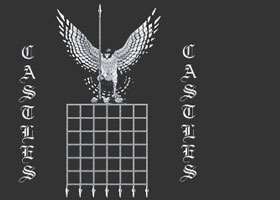But there is some evidence that King Arthur might have been based on a real person so is it therefore unreasonable to expect that a place called Camelot also existed? The Historia Regum Britanniae - the History of the King's of Britain was written in 1136 by Geoffrey of Monmouth and detailed the old Kings and history dating from the Roman era and climaxing with the reign of King Arthur. Geoffrey made no mention of a place called Camelot. Geoffrey of Monmouth sets King Arthur's court at Caerleon in Wales. Monmouth describes Caerleon as being "Situated on the River Usk, not far from the Severn Sea, in a most pleasant position, and being richer in material wealth than other townships". So where did the name of the place called Camelot originate? The Legends of CamelotThe Legends of Camelot - Did Camelot ever really exist
- The Legends of Camelot
- Where was Camelot located?
- Who first made reference to Camelot?
- Did King Arthur really live in a place called Camelot and who was Merlin?
Where did the name Camelot originate?
The oldest known literature about King Arthur makes no reference to Camelot by name. Camelot is first mentioned explicitly in the romance called Lancelot written by the French poet Chretien de Troyes between 1170 and 1185. The patroness of Chretien de Troyes was the Countess Marie de Champagne who was the daughter of Eleanor of Aquitaine who married King Henry II of England. The name Camelot is mentioned as follows:"Upon a certain Ascension Day King Arthur had come from Caerleon, and had held a very magnificent court at Camelot as was fitting on such a day." Chretien de Troyes mentions Caerleon, as had Geoffrey of Monmouth, but in his work King Arthur had moved to another court in Camelot. The Legends and Origins of Camelot - Was Camelot located in Winchester?
Was Camelot located in Winchester? There is a massive Round Table in the Great Hall at Winchester which was said to be King Arthur's Round Table. Winchester was first identified as the Camelot of legend by Sir Thomas Malory in his "Le Morte D'Arthur" which was first printed by Caxton in 1485. The Legends and Origins of Camelot - Was Camelot located in Cornwall?
There is some speculation that Camelot was derived from the Latin word 'Camelodunum'. Is Camelot is associated with the River Camel in Cornwall? Or is Camelot and King Arthur associated with Tintagel Castle? The association of King Arthur with Tintagel Castle was thought to be another legend, another myth. All that is left of Tintagel Castle is a ruin of a Medieval Castle built in the 12th Century. It was believed that a small monastery previously existed on the site which dated back to the 6th Century. However, a summer fire burned away surfaces of earth at Tintagel revealing that nearly two hundred buildings had previously existed on the site - not just a single monastery! A piece of slate was also found which had a very rare inscription from the Dark Ages dating the artefact to the late fifth century - the time that a man, similar to King Arthur, was said to have ruled. Pottery was also found at the site which originated in the Byzantine Empire. Tintagel was clearly an important trading place in the Dark Ages and must also have been home to an important person. This new information from Tintagel is intriguing - normally evidence is found which disproves any connection between the legend of Camelot and King Arthur - we now have evidence which possibly links this place with a powerful King of the Dark Ages! The Legends of Camelot - other locations...
The term "Camelot" (Camallate) was used in 1542 by John Leland, who identified "South Cadbyri"( Cadbury Castle in Somerset) as the setting for King Arthur's court of Camelot. The remains of an ancient hillfort can be found on this site at South Cadbury. The refernce to Camelot by John Leland is as follows: "At the very south end of the church of South-Cadbyri standeth Camallate, sometime a famous town or castle. . .The people can tell nothing there but that they have heard Arthur much resorted to Camalat." The old villages of Queen Camel and West Camel are not far away from this site and some belive that Leland was influenced by these local place names when making reference to 'Camallate'. The Legends of Camelot
The legends of Camelot are legion - there are no definitive answers! | 
